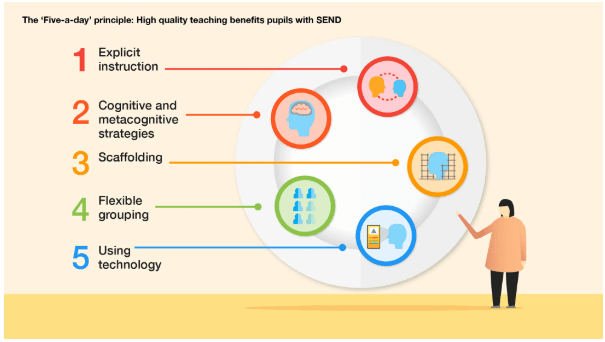The research underpinning the EEF’s guidance report ‘Special Educational Needs in Mainstream Schools’ indicates that supporting high quality teaching improves outcomes for pupils with SEND. Five specific approaches—the ‘Five-a-day’ indicated below—are particularly well-evidenced as having a positive impact. Teachers should develop a repertoire of these strategies, which they can use daily and flexibly in response to individual needs, using them as the starting point for classroom teaching for all pupils, including those with SEND.

1 - Explicit Instruction
Teacher-led approaches with a focus on clear explanations, modelling and frequent checks for understanding. This is then followed by guided practice, before independent practice.
2 - Cognitive and metacognitive strategies
Managing cognitive load is crucial if new content is to be transferred into students’ long-term memory. Provide opportunities for students to plan, monitor and evaluate their own learning.
3 – Scaffolding
When students are working on a written task, provide a supportive tool or resource such as a writing frame or a partially completed example. Aim to provide less support of this nature throughout the course of the lesson, week or term.
4 – Flexible grouping
Allocate groups temporarily, based on current level of mastery. This could, for example, be a group that comes together to get some additional spelling instruction based on current need, before re-joining the main class.
5 - Using technology
Technology can be used by a teacher to model worked examples; it can be used by a student to help them to learn, to practice and to record their learning. For instance, you might use a class visualiser to share students’ work or to jointly rework an incorrect model.
More Information

Notifications